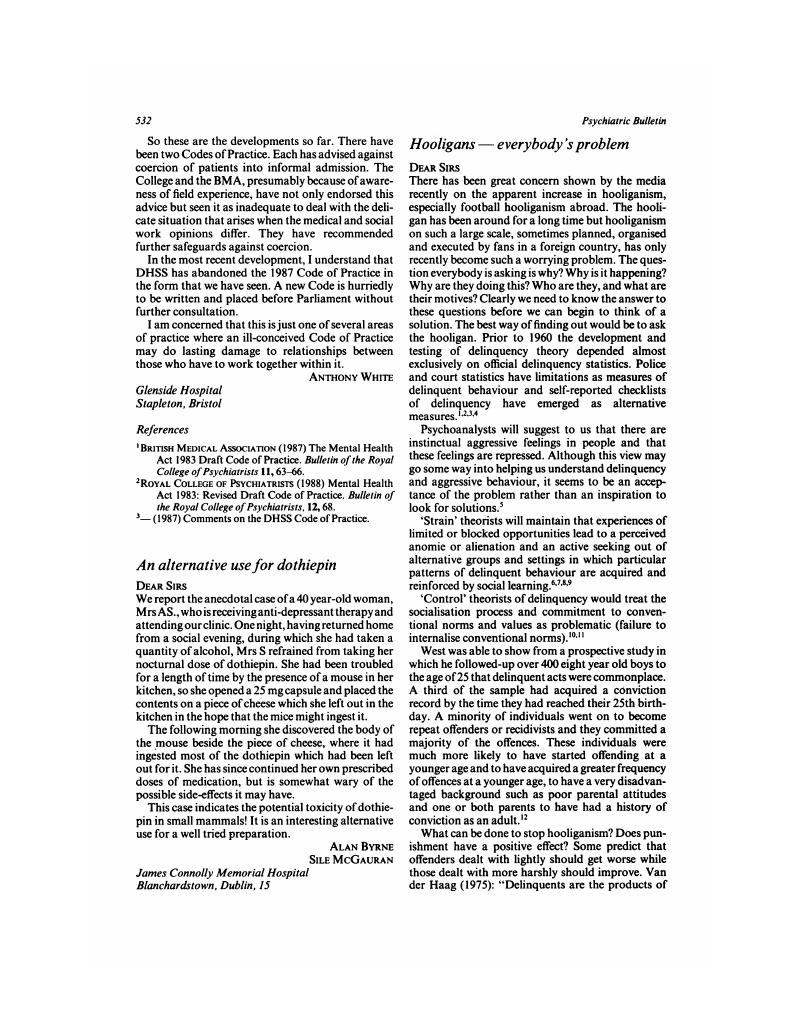No CrossRef data available.
Article contents
Hooligans — everybody's problem
Published online by Cambridge University Press: 02 January 2018
Abstract
An abstract is not available for this content so a preview has been provided. As you have access to this content, a full PDF is available via the ‘Save PDF’ action button.

- Type
- Correspondence
- Information
- Creative Commons
- This is an Open Access article, distributed under the terms of the Creative Commons Attribution (CC-BY) license (http://creativecommons.org/licenses/by/4.0/), which permits unrestricted re-use, distribution, and reproduction in any medium, provided the original work is properly cited.
- Copyright
- Copyright © Royal College of Psychiatrists, 1988
References
1.
Kohn, M. (1976) Looking book — A 25-Year review and appraisal of social problems research. Social Problems, 24, 94–112.Google Scholar
2.
De Fleur, L. (1975) Biasing influences on drug arrest records: implications deviance research. American Sociological Review, 40, 88–103.Google Scholar
3.
Williams, J. R. & Gold, M (1972) From delinquent behaviour to official delinquency. Social Problems, 20, 209–229.CrossRefGoogle Scholar
4.
Skogan, W. G. (1977) Dimensions of the dark figure of unreported crime. Crime and Delinquency, 23, 41–50.Google Scholar
5.
Freud, S. (1974) The Standard Edition of the Complete Psychological Works of, Volume XXI, London: Hogarth Press and the Institute of Psycho-analysis, 10–12.Google Scholar
6.
Durkheim, E. (1938) The Rules of Sociological Method. (ed. Catlini, G. E. G.) Chicago: University of Chicago Press.Google Scholar
7.
Merton, R. K. (1957) Social Theory and Social Structure.
Glencoe, Ill.: Free Press.Google Scholar
8.
Cloward, R. & Ohlin, L. E. (1960) Delinquency and Opportunity: A Theory of Delinquent Groups.
Glencoe, Ill.: Free Press.Google Scholar
9.
Bandura, A (1973) Aggression: A Social Learning Analysis.
Englewood Cliffs, N. J.: Prentice Hall.Google Scholar
10.
Reiss, A. J. & Reiss, J. R. (1951) Delinquency as the failure of personal and social controls. American Sociological Review, 16, 196–207.Google Scholar
11.
Hirschi, T. (1969) Causes of Delinquency.
Berkeley, California: University of California Press.Google Scholar
12.
West, D. J. (1982) Delinquency: Its Roots, Career and Prospects.
London: Heinemann.Google Scholar
13.
Farrington, D. P. (1978) The effectiveness of sentences. Justice of the Peace, 142, 68–71.Google Scholar
14.
Dinitz, S. & Conrad, J. P. (1980) The dangerous 2%. In Critical Issues in Juvenile Delinquency. (eds. Shichor, D. & Kelly, D.) Lexington, Mass.: D. C. Heath.Google Scholar



eLetters
No eLetters have been published for this article.